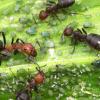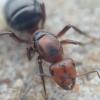I really think they should both be described as either neoniger or niger as they both arnt that different to me, and instead, they should be described as a slightly different strain, not too different, but also not too similar. I think they might be evolving into 2 different species during our time. Who knows?
I do understand that they seem very similar to those who are unfamiliar or newer to the world of ants, but I can promise you that they are very definitively separate species. Lasius neoniger is just a name, it's not actually that similar, it's not the "American equivalent" to niger (if anything, that would be L. ponderosae); There are several species more similar to L. niger than L. neoniger is. As previously mentioned in this thread they differ in several notable characters, including coloration, habitat and ecology, and morphology. They're also genetically quite distinct too. The most recent phylogeny I could find that includes L. neoniger is the one in Schär et al., 2022, which places L. niger and L. neoniger in completely separate clades of the former subgenus Lasius.
Human brains love to see patterns and place things into categories, but the more distant, the more dissimilar they are from us, the more we have a bias towards lumping stuff together. If we approached insects and their taxonomy the same way we do for our own taxonomic clades, if we were truly consistent with our taxonomy across all life, there would be so many more bug taxa. For example, according to Borowiec et al., 2021, the estimated crown age of the genus Formica is about 26 million years ago, give or take a few million. To compare that to the taxonomy of our own lineage, that's roughly equivalent (if my quick googling is correct) to the age of the Catarrhini, the lineage that contains all apes and old world monkeys.
Edited by Mettcollsuss, July 25 2024 - 8:10 AM.

















